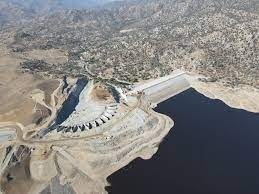Labyrinth Spillways

|
| Labyrinth Weir, London.
(Image Source: Wikimedia) |
Labyrinth weirs are a unique variation of conventional weirs designed to efficiently manage water flow in a wide range of hydraulic scenarios. They are characterized by their complex and interlocking geometry, resembling a labyrinth, which significantly enhances their flow control capabilities compared to traditional weirs. Their distinctive geometric layout creates a series of short but tortuous flow paths that offer increased resistance to the flowing water. This complexity causes a reduction in flow velocity, preventing turbulence and energy loss while achieving efficient flow regulation.
“The flow capacity of a weir is largely governed by the weir length and crest shape. A labyrinth weir is a linear weir folded in plan-view; these structures offer several advantages when compared to linear weir structures. Labyrinth weirs provide an increase in crest length for a given channel width, thereby increasing flow capacity for a given upstream head. As a result of the increased flow capacity, these weirs require less free board in the upstream reservoir than linear weirs, which facilitates flood routing and increases reservoir storage capacity under base flow conditions (weir height may be increased). In addition to spillways, labyrinth weirs are also effective drop structures, energy dissipaters, and flow aeration control structures."[1]
Several critical factors influence the design of labyrinth weirs including geometric configuration, flow characteristics, hydraulic efficiency, and structural integrity. The labyrinth layout consists of primary walls and secondary walls, forming a series of interconnected baffles. The dimensions and angles of these walls are essential in determining the weir's flow capacity and head-discharge relationship. As these weirs are effective across a wide range of flow rates and heads, the design must account for both subcritical and supercritical flow conditions to ensure optimal performance and prevent flow separation. Like all dams, the primary objective of labyrinth weirs is to maintain high hydraulic efficiency by reducing energy losses. Computational fluid dynamics (CFD) simulations and physical modeling play a crucial role in optimizing geometric parameters to achieve desired performance. Additionally, labyrinth weirs must be designed to withstand the hydraulic forces exerted by the flowing water. Structural stability and safety are of paramount importance, particularly in flood control applications.

|
| Labyrinth Spillway, ASCE.
Image Source: USACE |
Labyrinth weirs offer several advantages over traditional weirs including improved flow control, reduced energy dissipation, versatility, and space efficiency. The complex geometry of labyrinth weirs provides enhanced flow regulation, making them ideal for controlling water levels in rivers, channels, and reservoirs. By minimizing turbulence and energy loss, labyrinth weirs contribute to more efficient energy dissipation, which is crucial in preventing scour and erosion downstream. They are adaptable to various flow conditions and can be tailored to suit specific hydraulic requirements, making them suitable for both constant and variable flow scenarios and can also handle higher flow rates with a smaller footprint compared to conventional weirs, making them advantageous in space-constrained environments.
Labyrinth weirs find applications in diverse hydraulic scenarios such as flood control, irrigation systems, hydropower generation, and water treatment. Labyrinth weirs effectively mitigate flood risks by regulating discharge rates during heavy rainfall and preventing downstream inundation. They optimize water distribution in agricultural irrigation systems, ensuring equitable water supply to crops. Labyrinth weirs enhance the efficiency of hydropower plants by controlling water flow and maintaining reservoir levels. Finally, they contribute to efficient water treatment processes by managing water flow through various treatment stages.
Labyrinth weirs, with their intricate geometric design and hydraulic efficiency, provide enhanced flow control, reduce energy losses, and adapt to different flow conditions makes them a valuable addition to the toolkit of hydraulic engineers.
Citations:
Revision ID: 7690
Revision Date: 08/28/2023
